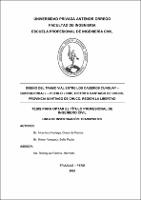Diseño del tramo vial entre los caseríos cunguay - querquerball - pueblo libre, distrito Santiago de chuco provincia Santiago de Chuco, región la libertad

View/Open
Download
(application/pdf: 23.93Mb)
(application/pdf: 23.93Mb)
Date
2020Author(s)
Alcántara Noriega, Diana de Fatima
Moran Vasquez, Sofia Paola
Metadata
Show full item recordAbstract
En nuestro país la falta de vías de comunicación sigue siendo un problema actual y nuestra región La Libertad no se ve exenta de esta carencia. La presencia de esta perjudica el comercio de las cosechas de la zona, desalienta el turismo y dificulta el acceso a instituciones educativas y centros de salud, entorpeciendo así las posibilidades de mejorar la calidad de vida La presente tesis tiene como objetivo principal proponer el diseño del tramo vial entre los caseríos Cunguay – Querquerball – Pueblo Libre, distrito de Santiago de Chuco, provincia de Santiago de Chuco, región La Libertad. Para lo cual iniciamos aplicando un protocolo de recolección de datos para posteriormente determinar el Índice Medio Diario Anual (IMDA) y Número de Ejes Equivalentes (EE), seguidamente realizamos el Estudio de Mecánica de Suelos con fines de pavimentación utilizando la normativa vigente: Manual de Ensayo de Materiales del Ministerio de Transportes y Comunicaciones, realizamos el Diseño Geométrico del tramo vial con análisis de alternativas, utilizando la normativa vigente: Manual de Carreteras DG-2018, posteriormente realizamos el Análisis Hidrológico y Diseño Hidráulico correspondiente, con la metodología del Manual de Hidrología, Hidráulica y Drenaje del Ministerio de Transportes y Comunicaciones, también determinamos los espesores de las capas del pavimento a nivel de afirmado mediante la metodología AASHTO 93 y el método NAASRA (National Association of Australian State Road Authorities, hoy AUSTROADS), elaboramos el Diseño de Señalización Vial utilizando la normativa vigente: Manual de Dispositivos de Control de Tránsito Automotor para Calles y Carreteras 2016 del Ministerio de Transportes y Comunicaciones y finalmente elaboramos el presupuesto estimado del costo total de la vía diseñada. El diseño se conformó por una carretera de Tercera Clase, ubicada sobre un terreno accidentado (tipo 3), constituida por una longitud de 6,703.36 m, una velocidad directriz de 40km/h, un radio mínimo de 45 metros, una pendiente máxima de 10%, una calzada conformada por dos carriles y un ancho de 6.00 metros, bermas de 0.50 metros, con un bombeo de 3% y un ancho mínimo de derecho de vía de 16 metros. Las cunetas son de sección triangular (0.38 metros de profundidad, 0.75 metros de ancho, 1:1 de inclinación de talud interior, 1:2 de inclinación de talud exterior), además se proyecta instalar 14 alcantarillas de paso (TMC) y 21 alcantarillas de alivio (TMC). El pavimento está conformado por una capa de 20 cm de material Afirmado y 15 cm de sub base granular. Se realizó el diseño de la señalización vial correspondiente y se estimó el costo directo que asciende a la suma de S/. 3’ 592, 616.98. In our country the lack of communication channels is still a current problem and our La Libertad region is not exempt from this lack. The presence of this, harms the trade of crops in the area, discourages tourism and hinders access to educational institutions and health centers, thus hindering the possibilities of improving the quality of life The main objective of this thesis is to propose the design of the road section between the Cunguay - Querquerball - Pueblo Libre hamlets, Santiago de Chuco district, Santiago de Chuco province, La Libertad region. For which we start by applying a data collection protocol to later determine the Annual Average Daily Index (IMDA) and Number of Equivalent Axes (EE), then we perform the Soil Mechanics Study for paving purposes using the current Test Manual regulations of Materials of the Ministry of Transportation and Communications, we perform the Geometric Design of the road section with analysis of alternatives, using the current regulations: Road Manual DG-2018, then we perform the corresponding Hydrological Analysis and Hydraulic Design, with the methodology of the Hydrology Manual, Hydraulics and Drainage of the Ministry of Transportation and Communications, we also determine the thicknesses of the pavement layers at the affirmative level using the AASHTO 93 methodology and the NAASRA method (National Association of Australian State Road Authorities, today AUSTROADS), we developed the Signaling Design Vial using the norm: Manual of Traffic Control Devices for Streets and Roads 2016 of the Ministry of Transportation and Communications and finally we prepare the estimated budget of the total cost of the designed road. The design is formed by a Third Class road, located on rough terrain (type 3), has a length of 6,703.36 meters, driving speed of 40 km/h, a minimum radius of 45 meters, a maximum slope of 10%, a shaped road by two lanes and a width of 6.00 meters, berms of 0.50 meters, with a pumping of 3% and a minimum right of track width of 16 meters. The ditches are of triangular section (0.38 meters deep, 0.75 meters wide, 1: 1 slope of interior slope, 1: 2 slope of external slope), it is also planned to install 14 passage sewers (TMC) and 21 sewers of relief (TMC). The pavement is made up of a 20 cm layer of Affirmed material and 15 cm of granular subbase. The design of the corresponding road signs was made, and the direct cost was estimated that amounts to the sum of S/. 3’ 592, 616.98
Collections
- Ingeniería Civil [1391]

